Assessing Groundwater Level with a Unified Seasonal Outlook and Hydrological Modeling Projection
Abstract
:1. Introduction
2. Methodology
2.1. Seasonal Rainfall Outlook
2.2. Weather Generator (WGEN)
2.3. Watershed Models
3. Study Site and Modeling Configurations
3.1. Basin Information
3.2. Modeling Configuration and Calibrations
4. Results and Discussion
4.1. Model Validation
4.2. Rainfall Generation by WGEN
4.3. Groundwater Table According to Seasonal Rainfall Outlooks
5. Conclusions
Author Contributions
Funding
Acknowledgments
Conflicts of Interest
References
- Aeschbach-Hertig, W.; Gleeson, T. Regional strategies for the accelerating global problem of groundwater depletion. Nat. Geosci. 2012, 5, 853. [Google Scholar] [CrossRef]
- Oki, T.; Kanae, S. Global hydrological cycles and world water resources. Science 2006, 313, 1068–1072. [Google Scholar] [CrossRef] [PubMed] [Green Version]
- Mackay, J.; Jackson, C.; Brookshaw, A.; Scaife, A.; Cook, J.; Ward, R. Seasonal forecasting of groundwater levels in principal aquifers of the United Kingdom. J. Hydrol. 2015, 530, 815–828. [Google Scholar] [CrossRef] [Green Version]
- Prudhomme, C.; Hannaford, J.; Harrigan, S.; Boorman, D.; Knight, J.; Bell, V.; Jackson, C.; Svensson, C.; Parry, S.; Bachiller-Jareno, N.; et al. Hydrological Outlook UK: Operational streamflow and groundwater level forecasting system at monthly to seasonal time scales. Hydrol. Sci. J. 2017, 62, 2753–2768. [Google Scholar] [CrossRef] [Green Version]
- Emerton, R.; Zsoter, E.; Arnal, L.; Cloke, H.L.; Muraro, D.; Prudhomme, D.; Stephens, E.M.; Salamon, P. Developing a global operational seasonal hydro-meteorological forecasting system: GloFAS-Seasonal v1.0. Geosci. Model Dev. 2018, 11, 3327–3346. [Google Scholar] [CrossRef] [Green Version]
- Hsu, H.H.; Chen, C.T.; Lu, M.M.; Chen, Y.M.; Chou, C.; Wu, Y.C. Climate Change in Taiwan: Scientific Report 2011; National Science and Technology Center for Disaster Reduction: New Taipei City, Taiwan, 2011; p. 67. (In Chinese)
- Wu, R.S.; Shih, D.S. Modeling hydrological impacts of groundwater level in the context of climate and land cover change. Terr. Atmos. Ocean. Sci. 2018, 29, 341–353. [Google Scholar] [CrossRef] [Green Version]
- Clark, M.P.; Hay, L.E. Use of medium-range numerical weather prediction model output to produce forecasts of streamflow. J. Hydrometeorol. 2004, 5, 15–32. [Google Scholar] [CrossRef]
- Wood, A.W.; Maurer, E.P.; Kumar, A.; Lettenmaier, D.P. Long-range experimental hydrologic forecasting for the eastern United States. J. Geophys. Res. Atmos. 2002, 107, ACL 6-1–ACL 6-15. [Google Scholar] [CrossRef]
- Bastola, S.; Misra, V.; Li, H. Seasonal hydrological forecasts for watersheds over the southeastern United States for the boreal summer and fall seasons. Earth Interact 2013, 17, 1–22. [Google Scholar] [CrossRef]
- Verdin, A.; Rajagopalan, B.; Kleiber, W.; Podestá, G.; Bert, F. A conditional stochastic weather generator for seasonal to multi-decadal simulations. J. Hydrol. 2018, 556, 835–846. [Google Scholar] [CrossRef]
- Richardson, C.W. Stochastic simulation of daily precipitation, temperature, and solar radiation. Water Resour. Res. 1981, 17, 182–190. [Google Scholar] [CrossRef]
- Tung, C.P.; Liu, T.M.; Chen, S.W.; Ke, K.Y.; Li, M.H. Carrying capacity and sustainability appraisals on regional water supply systems under climate change. Int. J. Environ. Clim. Chang. 2014, 4, 27–44. [Google Scholar] [CrossRef]
- Pickering, N.B.; Stedinger, J.R.; Haith, D.A. Weather input for nonpoint-source pollution models. J. Irrig. Drain. Eng. 1988, 114, 674–690. [Google Scholar] [CrossRef]
- Selker, J.S.; Haith, D.A. Development and Testing of Single-Parameter Precipitation Distributions. Water Resour. Res. 1990, 26, 2733–2740. [Google Scholar] [CrossRef] [Green Version]
- Liu, T.M.; Tung, C.P.; Ke, K.Y.; Chuang, L.H.; Lin, C.Y. Application and development of a decision-support system for assessing water shortage and allocation with climate change. Paddy Water Environ. 2009, 7, 301–311. [Google Scholar] [CrossRef]
- Tung, C.P.; Haith, D.A. Global-warming effects on New York stream flows. J. Water Resour. Plan. Manag. 1995, 121, 216–225. [Google Scholar] [CrossRef]
- Yeh, G.T.; Shih, D.S.; Cheng, J.R.C. An integrated media, integrated processes watershed model. Comput. Fluids 2011, 45, 2–13. [Google Scholar] [CrossRef]
- Harbaugh, A.W. MODFLOW-2005, the US Geological Survey modular ground-water model—The ground-water flow process. In Techniques and Methods 6-A16; U.S. Geological Survey: Reston, VA, USA, 2005. [Google Scholar]
- Markstrom, S.L.; Niswonger, R.G.; Regan, R.S.; Prudic, D.E.; Barlow, P.M. GSFLOW-Coupled Ground-water and Surface-water FLOW model based on the integration of the Precipitation-Runoff Modeling System (PRMS) and the Modular Ground-Water Flow Model (MODFLOW-2005). In Techniques and Methods 6-D1; U.S. Geological Survey: Reston, VA, USA, 2008; 240p. [Google Scholar]
- Kim, N.W.; Chung, I.M.; Won, Y.S.; Arnold, J.G. Development and application of the integrated SWAT–MODFLOW model. J. Hydrol. 2008, 356, 1–16. [Google Scholar] [CrossRef]
- Bailey, R.T.; Wible, T.C.; Arabi, M.; Records, R.M.; Ditty, J. Assessing regional-scale Spatio-temporal patterns of groundwater-surface water interactions using a coupled SWAT-MODFLOW model. Hydrol. Process. 2016, 30, 4420–4433. [Google Scholar] [CrossRef]
- Bailey, R.; Rathjens, H.; Bieger, K.; Chaubey, I.; Arnold, J. SWATMOD-Prep: Graphical user interface for preparing coupled SWAT-MODFLOW simulations. J. Am. Water Resour. Assoc. 2017, 53, 400–410. [Google Scholar] [CrossRef]
- Ross, M.; Geurink, J.; Said, A.; Aly, A.; Tara, P. Evapotranspiration conceptualization in the HSPF-MODFLOW integrated models. J. Am. Water Resour. Assoc. 2005, 41, 1013–1025. [Google Scholar] [CrossRef]
- Swain, E.D. Implementation and Use of Direct-Flow Connections in a Coupled Ground-Water and Surface-Water Model. Groundwater 1994, 32, 139–144. [Google Scholar] [CrossRef]
- Refsgaard, J.C.; Storm, B. MIKE SHE, in Computer Models of Watershed Hydrology; Singh, V.P., Ed.; Water Resources Publications: Littleton, CO, USA, 1995; pp. 809–846. [Google Scholar]
- Yeh, G.T.; Cheng, H.P.; Cheng, J.R.; Lin, J.H. A numerical model to simulate water flow and contaminant and sediment transport in watershed systems of 1-D stream-river network, 2-D overland regime, and 3-D subsurface media (WASH123D: Version 1.0). In Technical Report CHL-98-19; Waterways experiment station, US Army Corps of Engineers: Vicksburg, MS, USA, 1998. [Google Scholar]
- Yeh, G.T.; Huang, G.; Zhang, F.; Cheng, H.P.; Lin, H.C. WASH123D: A Numerical Model of Flow, Thermal Transport, and Salinity, Sediment, and Water Quality Transport in WAterSHed Systems of 1-D Stream-River Network, 2-D Overland Regime, and 3-D Subsurface Media; Office of Research and Development: Orlando, FL, USA, 2005. [Google Scholar]
- US Army Corps of Engineers (USACE). Hydrologic Modeling System HEC-HMS: Technical Reference Manual; Hydrologic Engineering Center: Davis, CA, USA, 2000. [Google Scholar]
- US Army Corps of Engineers (USACE). Hydrologic Modeling System HEC-HMS: Applications Guide; Hydrologic Engineering Center: Davis, CA, USA, 2008. [Google Scholar]
- Halwatura, D.; Najim, M. Application of the HEC-HMS model for runoff simulation in a tropical catchment. Environ. Model Softw. 2013, 46, 155–162. [Google Scholar] [CrossRef]
- Yu, P.S.; Yang, T.C.; Kuo, C.M.; Wang, Y.T. A stochastic approach for seasonal water-shortage probability forecasting based on seasonal weather outlook. Water Resour. Manag. 2014, 28, 3905–3920. [Google Scholar] [CrossRef]
- Semenov, M.A.; Brooks, R.J. Spatial interpolation of the LARS-WG stochastic weather generator in Great Britain. Clim. Res. 1999, 11, 137–148. [Google Scholar] [CrossRef] [Green Version]
- Wu, R.S.; Haith, D.A. Land use, climate, and water supply. J. Water Resour. Plan. Manag. 1993, 119, 685–704. [Google Scholar] [CrossRef]
- Shih, D.S.; Yeh, G.T. Identified model parameterization, calibration, and validation of the physically distributed hydrological model WASH123D in Taiwan. J. Hydrol. Eng. 2011, 16, 126–136. [Google Scholar] [CrossRef]
- Shih, D.S.; Liau, J.M.; Yeh, G.T. Model Assessments of Precipitation with a Unified Regional Circulation Rainfall and Hydrological Watershed Model. J. Hydrol. Eng. 2012, 17, 43–54. [Google Scholar] [CrossRef]
- Shih, D.S.; Hsu, T.W.; Chang, K.C.; Juan, H.L. Implementing Coastal Inundation Data with an Integrated Wind Wave Model and Hydrological Watershed Simulations. Terr. Atmos. Ocean Sci. 2012, 23, 513–525. [Google Scholar] [CrossRef] [Green Version]
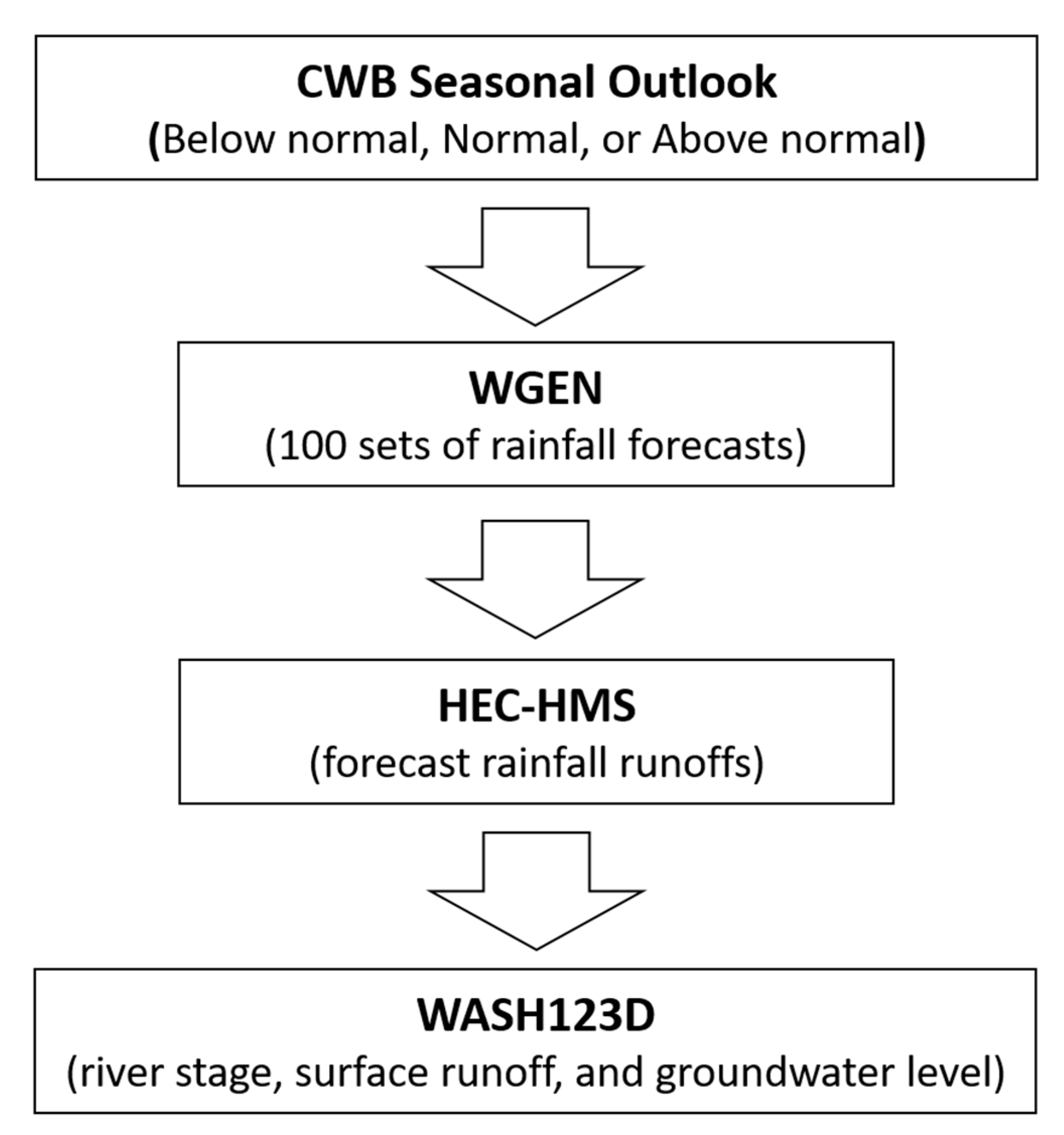
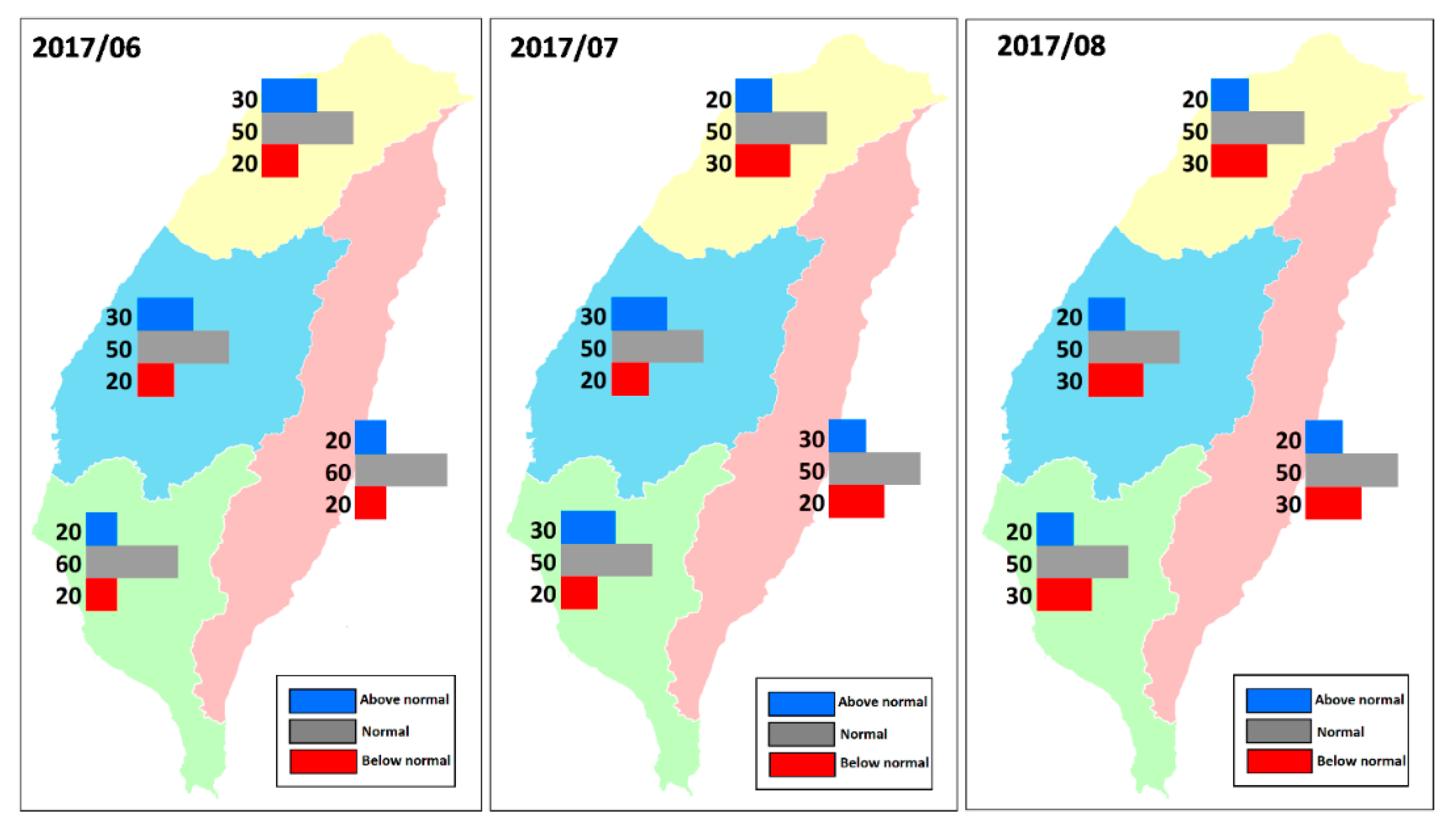

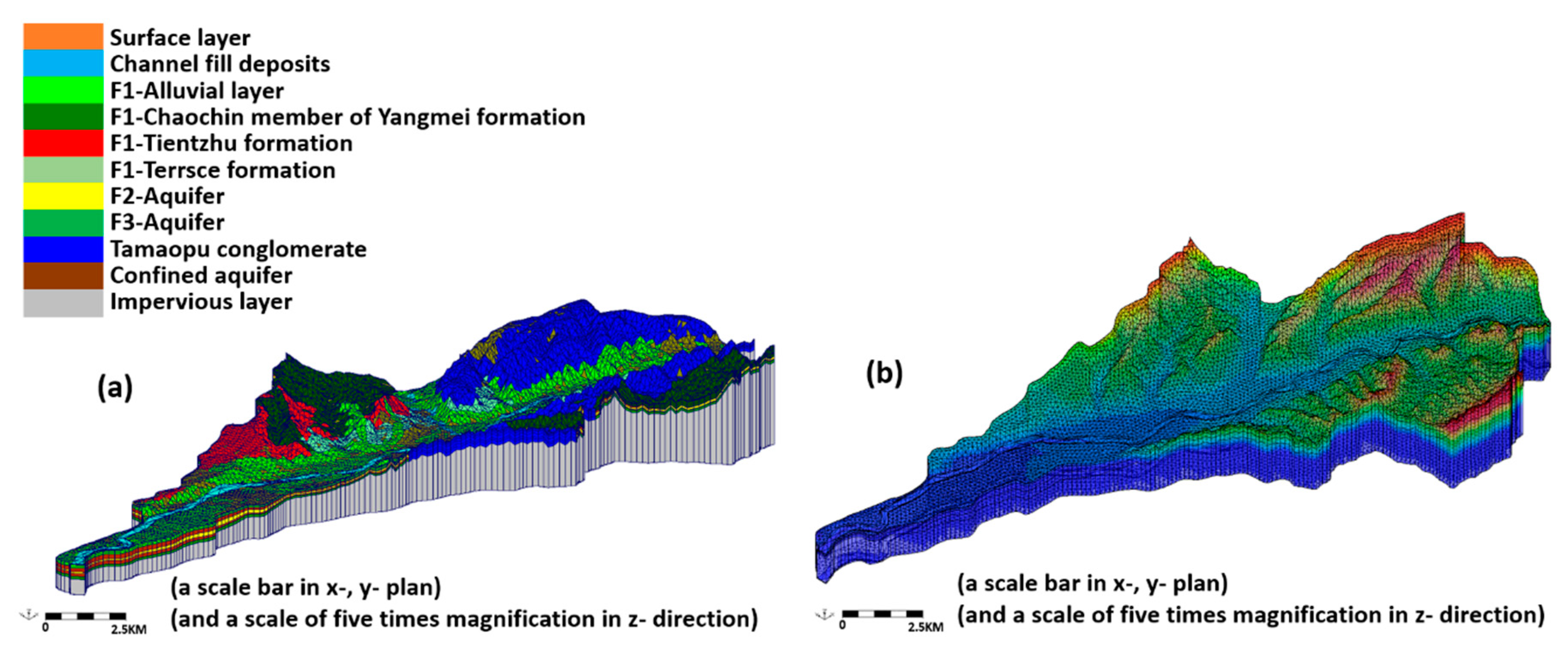
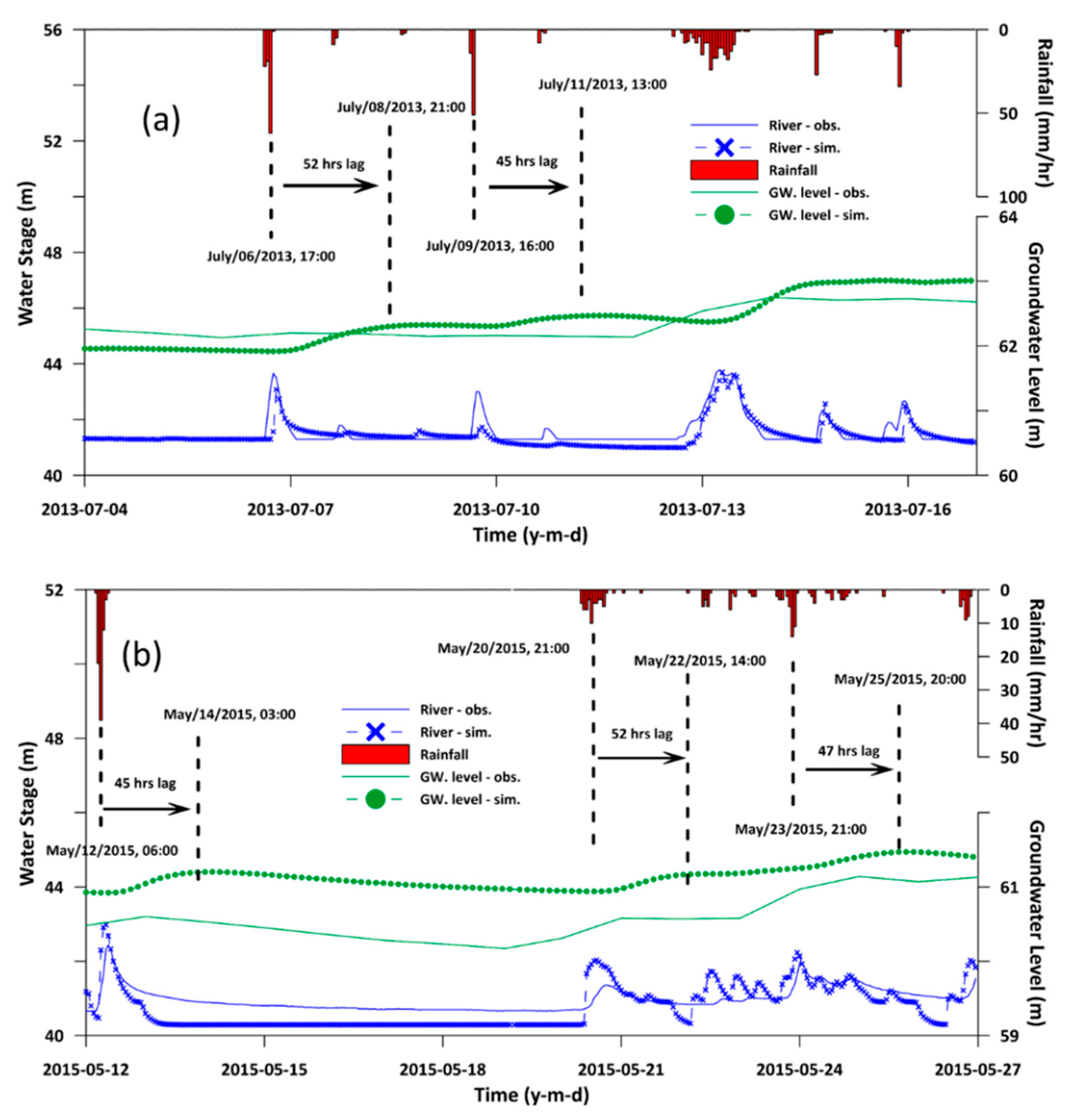

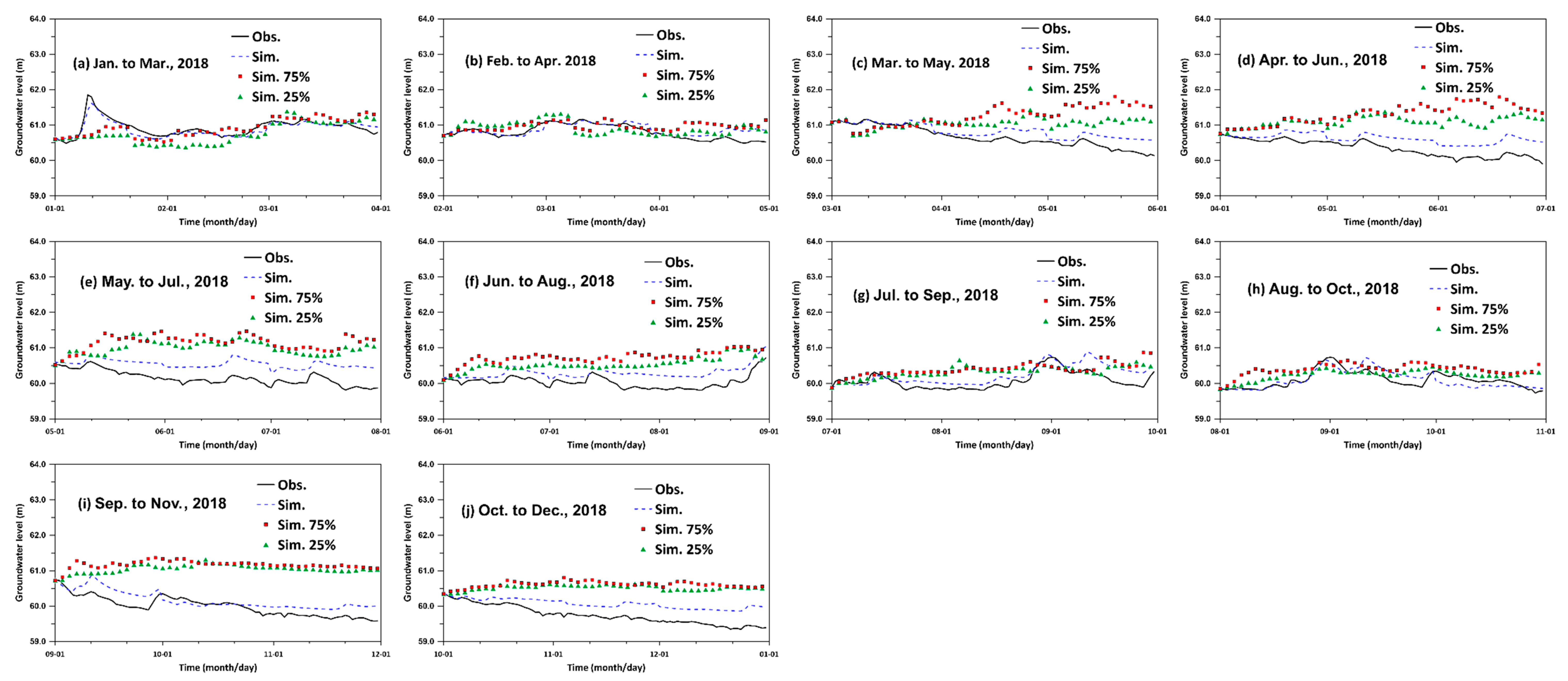
| HEC-HMS | WASH123D | ||
|---|---|---|---|
| SCS curve | Channels (1D) Mn | Surface land (2D) Mn | Groundwater layers (3D) Ks (m/s) |
| Initial loss (4.0 mm) Non-infiltration covers (17.6–22.1%) Lag time (131.2–147.2 min.) CN (51.9–62.3) | 0.036–0.029 | Metropolitan (0.120) Non-metropolitan (0.280) Other (0.085) | Gravel (1 × 10−3) Mud or fine silt (4 × 10−6) River sediment (2 × 10−5) Aquifers (1 × 10−3 to 1 × 10−5) Impermeable layer (1 × 10−8) |
| Model | Events | Coefficient of Determination (R2) | Root-Mean-Square Error (RMSE) | Nash–Sutcliffe Model Efficiency Coefficient (CE) |
|---|---|---|---|---|
| Surface water | Soulik (2013) | 0.910 | 0.253 | 0.896 |
| Kong-rey (2013) | 0.832 | 0.209 | 0.791 | |
| Soudelor (2015) | 0.817 | 0.479 | 0.803 | |
| Rainfall event (2015) | 0.840 | 0.176 | 0.807 | |
| Average | 0.850 | 0.279 | 0.824 | |
| Groundwater | 2013 (1 January–31 December) | 0.475 | 0.363 | 0.459 |
| 2014 (1 January–31 March) | 0.763 | 0.108 | 0.670 | |
| 2014 (1 July–31 October) | 0.638 | 0.195 | 0.471 | |
| 2015 (1 April–31 October) | 0.550 | 0.460 | 0.885 | |
| Average | 0.607 | 0.282 | 0.621 |
| Guanxi Station | 2018 | Real Occurrence (mm) | 25th Percentile of Simulation Rainfall (mm) | 75th Percentile of Simulation Rainfall (mm) | Seasonal Forecast A/N/B | Hit/Miss |
|---|---|---|---|---|---|---|
| 1st | Jan. | 267.0 | 55.2 | 55.5 | 10/60/30 | |
| Feb. | 147.5 | 101.0 | 154.9 | 10/60/30 | ||
| Mar. | 57.0 | 121.6 | 267.3 | 10/60/30 | ||
| Total | 471.5 | 277.8 | 477.7 | Hit | ||
| 2nd | Feb. | 147.5 | 19.2 | 146.3 | 10/50/40 | |
| Mar. | 57.0 | 232.0 | 237.7 | 20/60/20 | ||
| Apr. | 85.5 | 111.0 | 279.2 | 30/50/20 | ||
| Total | 290.0 | 362.2 | 663.2 | Miss | ||
| 3rd | Mar. | 57.0 | 120.0 | 353.9 | 20/60/20 | |
| Apr. | 85.5 | 107.9 | 122.1 | 30/50/20 | ||
| May | 85.0 | 211.3 | 277.9 | 30/50/20 | ||
| Total | 227.5 | 439.2 | 753.9 | Miss | ||
| 4th | Apr. | 85.5 | 233.7 | 326.2 | 20/50/30 | |
| May | 85.0 | 227.5 | 374.0 | 20/50/30 | ||
| Jun. | 177.0 | 232.6 | 274.6 | 30/50/20 | ||
| Total | 347.5 | 693.8 | 974.8 | Miss | ||
| 5th | May | 85.0 | 240.2 | 355.5 | 10/50/40 | |
| Jun. | 177.0 | 346.0 | 396.5 | 20/50/30 | ||
| Jul. | 199.0 | 231.3 | 603.8 | 20/50/30 | ||
| Total | 461.0 | 817.5 | 1328.8 | Miss | ||
| 6th | Jun. | 177.0 | 387.6 | 580.6 | 20/50/30 | |
| Jul. | 199.0 | 147.2 | 194.8 | 20/50/30 | ||
| Aug. | 659.5 | 139.8 | 274.5 | 20/50/30 | ||
| Total | 1035.5 | 674.6 | 1049.9 | Hit | ||
| 7th | Jul. | 199.0 | 190.3 | 249.3 | 30/50/20 | |
| Aug. | 659.5 | 177.7 | 235.0 | 20/50/30 | ||
| Sep. | 182.0 | 296.0 | 335.8 | 20/50/30 | ||
| Total | 1040.5 | 664 | 820.1 | Miss | ||
| 8th | Aug. | 659.5 | 315.9 | 377.9 | 20/50/30 | |
| Sep. | 182.0 | 117.1 | 361.4 | 20/50/30 | ||
| Oct. | 84.5 | 45.3 | 52.6 | 20/50/30 | ||
| Total | 926.0 | 478.3 | 791.9 | Miss | ||
| 9th | Sep. | 182.0 | 224.6 | 442.8 | 20/50/30 | |
| Oct. | 84.5 | 55.4 | 114.8 | 10/60/30 | ||
| Nov. | 47.5 | 64.7 | 65.9 | 20/50/30 | ||
| Total | 314.0 | 344.7 | 623.5 | Miss | ||
| 10th | Oct. | 84.5 | 57.9 | 229.1 | 10/60/30 | |
| Nov. | 47.5 | 8.7 | 29.5 | 10/50/40 | ||
| Dec. | 39.0 | 67.2 | 138.2 | 20/60/20 | ||
| Total | 171.0 | 133.8 | 376.0 | Hit | ||
| Xinpu Station | 2018 | Real Occurrence (mm) | 25th Percentile of Simulation Rainfall (mm) | 75th Percentile of Simulation Rainfall (mm) | Seasonal Forecast A/N/B | Hit/Miss |
|---|---|---|---|---|---|---|
| 1st | Jan. | 272.0 | 31.0 | 83.2 | 10/60/30 | |
| Feb. | 98.5 | 99.9 | 218.8 | 10/60/30 | ||
| Mar. | 54.0 | 119.9 | 166.4 | 10/60/30 | ||
| Total | 424.5 | 250.8 | 468.4 | Hit | ||
| 2nd | Feb. | 98.5 | 78.9 | 180.7 | 10/50/40 | |
| Mar. | 54.0 | 93.0 | 235.7 | 20/60/20 | ||
| Apr. | 54.0 | 161.2 | 217.7 | 30/50/20 | ||
| Total | 206.5 | 333.1 | 634.1 | Miss | ||
| 3rd | Mar. | 54.0 | 104.0 | 139.8 | 20/60/20 | |
| Apr. | 54.0 | 129.3 | 238.1 | 30/50/20 | ||
| May | 49.0 | 195.3 | 313.1 | 30/50/20 | ||
| Total | 157.0 | 428.6 | 691 | Miss | ||
| 4th | Apr. | 54.0 | 87.7 | 108.1 | 20/50/30 | |
| May | 49.0 | 209.7 | 355.3 | 20/50/30 | ||
| Jun. | 113.0 | 325.7 | 335.4 | 30/50/20 | ||
| Total | 216.0 | 623.1 | 798.8 | Miss | ||
| 5th | May | 49.0 | 262.1 | 346.0 | 10/50/40 | |
| Jun. | 113.0 | 147.3 | 180.3 | 20/50/30 | ||
| Jul. | 69.0 | 135.7 | 156.3 | 20/50/30 | ||
| Total | 231.0 | 545.1 | 682.6 | Miss | ||
| 6th | Jun. | 113.0 | 123.1 | 234.5 | 20/50/30 | |
| Jul. | 69.0 | 58.9 | 138.6 | 20/50/30 | ||
| Aug. | 251.0 | 240.2 | 280.2 | 20/50/30 | ||
| Total | 433.0 | 422.2 | 653.3 | Hit | ||
| 7th | Jul. | 69.0 | 116.7 | 147.1 | 30/50/20 | |
| Aug. | 251.0 | 157.0 | 176.5 | 20/50/30 | ||
| Sep. | 202.5 | 111.9 | 220.4 | 20/50/30 | ||
| Total | 522.5 | 385.6 | 544 | Hit | ||
| 8th | Aug. | 251.0 | 144.8 | 212.6 | 20/50/30 | |
| Sep. | 202.5 | 113.7 | 134.1 | 20/50/30 | ||
| Oct. | 54.0 | 64.3 | 115.9 | 20/50/30 | ||
| Total | 507.5 | 322.8 | 462.6 | Miss | ||
| 9th | Sep. | 202.5 | 103. 7 | 197.0 | 20/50/30 | |
| Oct. | 54.0 | 79.4 | 99.2 | 10/60/30 | ||
| Nov. | 42.0 | 23.0 | 50.2 | 20/50/30 | ||
| Total | 298.5 | 206.1 | 346.4 | Hit | ||
| 10th | Oct. | 54.0 | 62.5 | 75.8 | 10/60/30 | |
| Nov. | 42.0 | 37.4 | 62.5 | 10/50/40 | ||
| Dec. | 36.0 | 40.9 | 64.3 | 20/60/20 | ||
| Total | 132.0 | 140.8 | 202.6 | Miss | ||
Publisher’s Note: MDPI stays neutral with regard to jurisdictional claims in published maps and institutional affiliations. |
© 2020 by the authors. Licensee MDPI, Basel, Switzerland. This article is an open access article distributed under the terms and conditions of the Creative Commons Attribution (CC BY) license (http://creativecommons.org/licenses/by/4.0/).
Share and Cite
Huang, J.-Y.; Shih, D.-S. Assessing Groundwater Level with a Unified Seasonal Outlook and Hydrological Modeling Projection. Appl. Sci. 2020, 10, 8882. https://doi.org/10.3390/app10248882
Huang J-Y, Shih D-S. Assessing Groundwater Level with a Unified Seasonal Outlook and Hydrological Modeling Projection. Applied Sciences. 2020; 10(24):8882. https://doi.org/10.3390/app10248882
Chicago/Turabian StyleHuang, Jing-Ying, and Dong-Sin Shih. 2020. "Assessing Groundwater Level with a Unified Seasonal Outlook and Hydrological Modeling Projection" Applied Sciences 10, no. 24: 8882. https://doi.org/10.3390/app10248882





